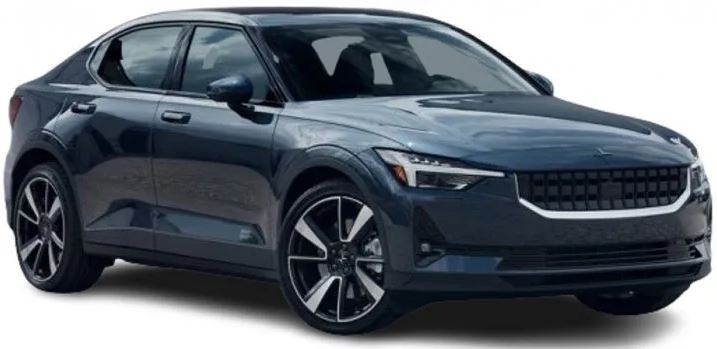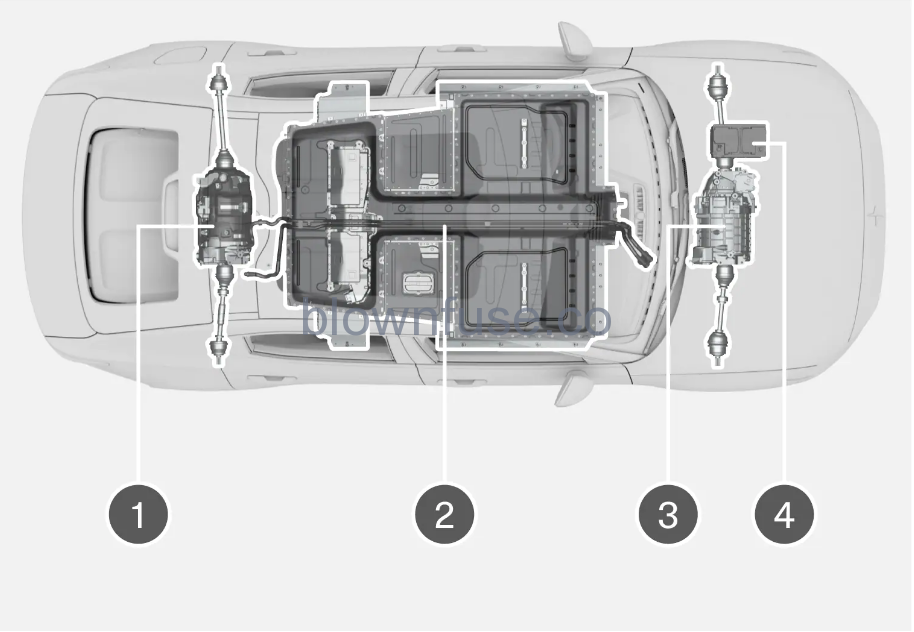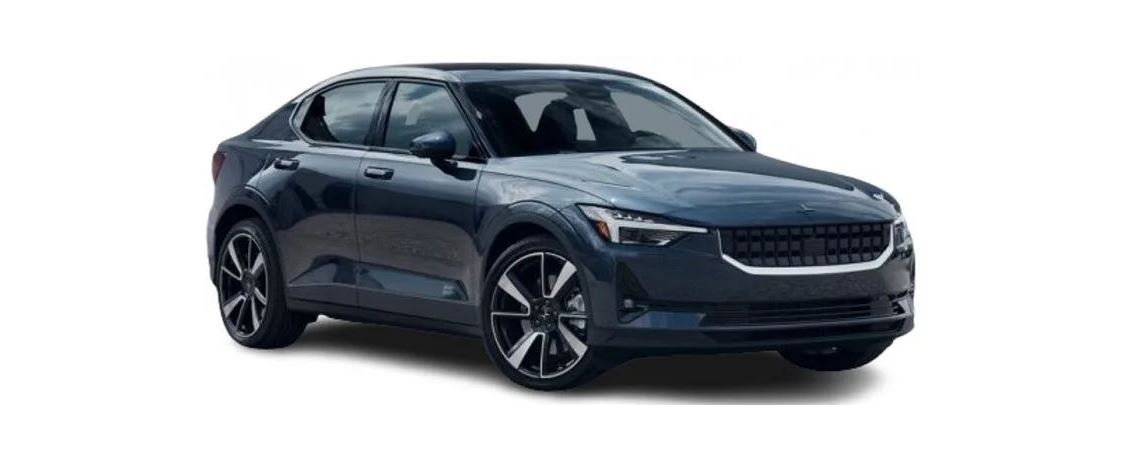2023 Polestar 2 Electric motor and charging General topics

Battery recycling
Consult with Polestar Customer Support if you have any questions or concerns about the disposal of this type of waste. Only authorized workshop personnel may handle high-voltage batteries.
Drive systems

- Electric motor – The vehicle contains two electric motors that power the vehicle and recover braking energy to convert it into electrical energy.
- High-voltage battery – The vehicle contains a high-voltage battery. The function of the high-voltage battery is to store energy. This energy is provided by plugging the charging cable into an electrical outlet and through regenerative braking.
- Electric motor – The vehicle’s electric motor powers the vehicle and recovers braking energy to convert it into electrical energy.
- 12 V battery – The vehicle contains a 12 V battery that starts the vehicle’s electrical system and powers the electrical equipment in the vehicle.
General information about charging
Different types of charging
The hybrid battery’s charging time depends on the amperage used. The 12 V battery is charged even when the vehicle is being charged.
Charging via wall outlet (AC charging)
The vehicle can be charged via a regular wall outlet. Suitable as extra charging for electric vehicles but not recommended for regular charging.
Charging via charging station (AC charging)
The charging station may be equipped with either a permanent charging cable or with a socket where a mode 3 charging cable can be connected. This type of charging is recommended for regular charging.
Rapid charging via charging station (DC charging)
The vehicle supports rapid charging with direct current (DC) at charging stations supporting the CCS (Combined Charging System) standard. Charging with direct current usually enables higher charging output and thereby shorter charging times. The highest charging output is normally achieved when the charge level of the battery is 0-30%, after which the charging output gradually decreases.
Temperature effect
The hybrid battery with an associated electrical drive system works better when they are at the correct operating temperature.
The high voltage battery may have reduced performance if the temperature in the battery is too low or too high.
Leaving the vehicle for prolonged periods at temperatures under –10 °C (14 °F) or over 40 °C (104 °F) may reduce the performance of the high-voltage battery. Plug in the vehicle to charge to help prevent the battery from becoming too hot or too cold.
The capacity of the high-voltage battery decreases somewhat with age and use.
California Proposition 65
Operating, servicing, and maintaining a passenger vehicle can expose you to chemicals including engine exhaust, carbon monoxide, phthalates, and lead, which are known to the State of California to cause cancer and birth defects or other reproductive harm. To minimize exposure, avoid breathing exhaust, do not idle the engine except as necessary, service your vehicle in a well-ventilated area and wear gloves or wash your hands frequently when servicing your vehicle. For more information go to www.P65Warnings.ca.gov/passenger-vehicle.
If the high-voltage battery needs to be replaced, contact Polestar Customer Support.
Exterior Sound
When the vehicle is being powered by electricity, an artificial exterior sound will play in the background. This sound is intended to help warn children, pedestrians, cyclists, animals, etc. outside the vehicle of the vehicle’s approach.
High-voltage electrical current

The electrical system in your vehicle uses a high-voltage electrical current. Any damage to this system or to the high-voltage battery may result in the danger of overheating, fire, or serious injury. If the vehicle is involved in a collision or exposed to flooding, fire, etc., contact Polestar Customer Support. Prior to this inspection, the vehicle should be parked outdoors at a safe distance from any building or potentially flammable materials.
A number of electrical components in the vehicle use high-voltage current and can be extremely dangerous if handled incorrectly. These components and any orange wiring in the vehicle may only be handled by trained and qualified Polestar service technicians.
Do not touch anything that is not clearly described in this Owner’s Manual.
High-voltage battery recommendations
Charging
When time and opportunity allow, choose AC charging rather than DC rapid charging. AC charging is gentler on the high-voltage battery, particularly in the case of regular charging.
High charge level
Avoid charging the vehicle to 100% unless the entire range is needed for the trip.
The battery can be damaged by maintaining a very high charge level for a long period of time. For this reason, avoid leaving the vehicle plugged in for charging for more than the recommended charge level, which is shown in the center display.
Low charge level
The high-voltage battery could be severely damaged if it is not recharged after becoming completely discharged. Because some consumption and natural battery discharge occur even when the vehicle is not being used, the charge level can drop to 0% if the vehicle is left unplugged with a low charge level.
If the charge level is under 20%, charging is always recommended so as to not risk discharging the battery completely.
Long-term parking
To minimize the risk of battery damage during long-term parking (longer than one month), a charge level of 40-60% is recommended. Set the desired charge level in the center display.
- If the charge level is higher – drive the vehicle until the charge level is lower.
- If the charge level is lower – charge the vehicle.
If you plan to park the vehicle for longer than three months, continuous charging is recommended.
Regularly check the vehicle’s charge level and ensure that charging is functioning properly.
Parking in warm climates
Avoid exposing the vehicle to extreme temperatures. If there is a risk of temperatures reaching about 55 °C (131 °F), parking for longer than 24 hours should be avoided completely as this could seriously damage the battery.
High temperatures can damage the high-voltage battery, especially if it is exposed to these temperatures for a long period of time. If possible, always plug in the vehicle for charging in temperatures higher than 30 °C (86 °F). The vehicle can actively cool the battery while it is parked, but this consumes current and causes the charge level to drop. If the vehicle is charged during the time it is parked, the battery can be cooled without being discharged.
If possible, park in the shade if the outdoor temperature is high. Strong sunlight in combination with high outdoor temperatures can cause the vehicle and the high-voltage battery to become very warm.
Parking in cold climates
If the temperature of the high-voltage battery is low, its performance is temporarily reduced until the battery warms up again. Plug in the vehicle for charging and use preconditioning to avoid driving with reduced performance. The vehicle can then warm up the battery before driving without the charge level and range being decreased.
Plug the vehicle in for charging if you plan to park it for longer than 24 hours when the ambient temperature is under -30 °C (-22 °F).
It is not harmful to drive the vehicle when it indicates that performance is reduced due to low temperatures.
Range assistant
Optimizing range
The factors that the driver can influence to extend the range are speed, driving style, and climate settings.
To help guide drivers in their driving, real-time information is provided on the impact of each energy consumption factor on the range. If speed, driving style, or climate settings are adjusted, the estimated range is updated.
ECO climate can also be activated or deactivated in the range assistant.
- Tap.
- Select Range assistant.
- Activate or deactivate Eco climate.

